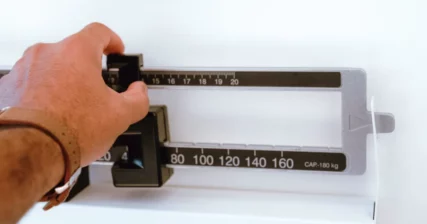Listen on: Apple Podcasts | Spotify
Weight training is the most important type of exercise for fat loss, overall health, and mental and physical strength and resilience.
No, that’s not a typo. Weight training is more important than cardio, even for getting and staying lean.
Unfortunately, through public health propaganda, we’ve been led to believe that low-fat, minimal meat diets and lots of cardio are the solution. They’re not.
A new study adds to the fat-burning benefits of resistance training.

Feel Better Fast. Guaranteed.
Energy+, EDGE, and MentaBiotics make up the Happy Juice supplement stack, with ingredients clinically proven to:
- decrease anxiousness scores by 55%
- decrease irritability scores by 60%
- decrease fatigue by 64%
- decrease anger 54%
- decrease tension by 45%
- decrease confusion by 43%
- decrease overall distress by 49%
- increase good bacteria by 70%
- decrease negative mood by 105%
- increase positive mood by 211%
How Resistance Training Stimulates Fat Loss
Strength training helps you shed fat through multiple mechanisms, some direct and some indirect.
Catecholamines and Lipolysis
This one is a bit technical, but I wanted to include it for those who get geeked out by physiology like I do.
In August of 2021, Vechetti IJ, et al. published Mechanical overload-induced muscle-derived extracellular vesicles promote adipose tissue lipolysis. Their research showed, for the first time, how resistance-trained muscles directly increase fat metabolism.
The catecholamines norepinephrine and epinephrine stimulate -adrenergic receptors in fat cells, which enhances insulin sensitivity, muscle mass, and metabolic rate.
Ephedrine was one of the most powerful supplements for triggering this process, which is why it was so effective for fat loss. However, the FDA banned its use in supplements in 2004 based on concerns of cardiovascular risk.
First using animal and human in vitro studies, and then animal and human in vivo studies, NAME, et al. found that overloaded muscle tissue, like that exposed to a hypertrophy-style strength training session, has a similar effect.
When skeletal muscles are overloaded, they release microRNA 1 (miR-1) containing extracellular vesicles (EVs). Epidydimal white adipose tissue (eWAT) then takes up those EVs, which increases B-adrenergic (AdrB3) expression, which increases lipolysis (fat breakdown).
Since the increased levels of catecholamines also increase overall energy expenditure, the fatty acids can then be used for energy, reducing fat mass.
Increased glycogen storage and reduced blood sugar
When you eat carbohydrates, you use them one of four ways:
- Burn them for your immediate energy needs
- Store them in your liver and muscle cells as glycogen
- Let the glucose float around in your blood, which causes significant damage as is seen in those with type II diabetes
- Convert them to triglycerides and fat
It would be impossible for most of us to eat a meal’s worth of carbohydrates, and then burn them immediately afterwards. That means the last three scenarios are the most likely. This is where resistance training comes in.
The more muscle you have, the more capacity you have for storing carbohydrates. That means when you eat them, you have a place to put them so they won’t leave you with elevated blood sugar and you won’t convert them to fat and get fatter.
Unfortunately, most diabetes doctors significantly under emphasize the importance of resistance training. They leave a patient feeling like strength training is an optional activity, rather than hitting them over the head with its importance.
Type II diabetes need not be a lifelong condition. At its core, it’s an issue of carbohydrate intolerance. By reducing dietary carbohydrates and increasing carbohydrate storage capacity through resistance training, most people can regain their health and don’t need to survive by using pharmaceuticals.
Supplements like berberine and other lifestyle hacks can help, too. But if you’re serious about controlling your blood sugar, you’ll make strength training a nonnegotiable part of your lifestyle.
By controlling blood sugar, you maintain lower insulin levels, which allows you to tap into your fat stores for more of your energy needs.
Improved strength and stamina which increases physical activity
Weak bodies tend to be more sedentary. Sedentary bodies lead to weak bodies. Without doing something you might not want to do, this downward cycle continues.
Weight training builds muscle and stamina, which makes it easier to carry out everyday activities.
The more strength and stamina you have, the more time you’ll spend on your feet instead of your seat.
On the flip-side, being sedentary not only reduces energy expenditure, it makes you insulin resistant, which leads to elevated insulin levels and more difficulty burning fat.
Increased post-exercise metabolic rate
Strength training causes micro-trauma in your muscle cells. The microscopic muscle damage is what triggers your body to build more muscle. That process requires energy, which means your metabolic rate remains elevated during this recovery period.
Research shows that your metabolic rate remains significantly higher even 24 hours after a training session.
The elevated energy expenditure coupled an increased reliance on fat for fuel means you burn more fat, even while resting between workouts.
Increased cortisol, growth hormone and testosterone
Calories, insulin, blood sugar, and catecholamines all impact fat metabolism, but so do a few other important hormones.
Cortisol is often seen as a villainous hormone, due to its connection with stress. However, an intense strength training session also increases cortisol, but only for a short time. The rise in cortisol stimulates fat breakdown (as well as protein and glycogen breakdown), making more fatty acids available for energy.
In addition, an acute rise in cortisol tends to increase growth hormone and testosterone.
Growth hormone and testosterone aid in muscle growth as well as fat metabolism. Both rise in response to intense strength training.
Get Started With Strength Training
I’m often disappointed when I talk to people who teach about, educate on, or sell products related to healthy lifestyles, who don’t strength train regularly.
Sadly, such folks often influence others, suggesting they can achieve optimal health and quality-of-life by doing whatever activity makes them feel good. That’s like a marriage therapist telling a couple that each individual should live their lives, doing whatever makes them feel good, and that they’ll end up with a rich and long-lasting marriage.
Can someone get lean without strength training? Sure! But simply being “lean” doesn’t mean someone is healthy. If you believe otherwise, stop by a meth clinic sometime.
Building muscle helps you stay lean and offers a host of other health benefits as well. It doesn’t feel easy, but it is easy to get started.
For example, I often start new VIGOR Training members with my Athlete-In-Training program. This three to six month program builds a solid strength training foundation, preparing them for more advanced movements and intense training, like that in VIGOR Everyday Athlete or VIGOR Strength Athlete.
In early stages of the program, members complete three strength training sessions per week and an active recovery session. Eventually, they transition to four strength training sessions, with each week building upon the previous week.
Though they’re often excited about the strength they gain, their most common feedback is about how much fat they lose, even in those who make minimal change to their diets.
I’m a bit biased, but I really believe in the programs I offer. So, if you’re ready to get started with resistance training, get started with VIGOR Training. If that’s not an option, hire a one-on-one personal trainer at your local gym.

Feel Better Fast. Guaranteed.
Energy+, EDGE, and MentaBiotics make up the Happy Juice supplement stack, with ingredients clinically proven to:
- decrease anxiousness scores by 55%
- decrease irritability scores by 60%
- decrease fatigue by 64%
- decrease anger 54%
- decrease tension by 45%
- decrease confusion by 43%
- decrease overall distress by 49%
- increase good bacteria by 70%
- decrease negative mood by 105%
- increase positive mood by 211%
Photo by Gordon Cowie on Unsplash



